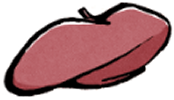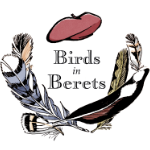
A vividly blue migratory songbird suggested by Lee C.
The Beginning of Birds in Berets
Birds in Berets is a collaborative sketch project where we share our love for birds and their individuality. But it started with an attempt to develop a single bird character to use as a mascot in an animated interstitial. When I posted several sketches to social media, I almost instantly received a response from Lee: “Do an Indigo Bunting next.” Together Lee and this Indigo Bunting character started an amazing series of bird designs from birders’ suggestions. If I haven’t done your favorite yet, make sure to drop a suggestion in the comments!
Indigo Buntings In Real Life
Indigo buntings are tiny birds, but the adult males do their very best to make themselves conspicuous on fenceposts and along the tops of hedges throughout most of the eastern United States. Their feathers are so blue they seem backlit or glowing, and their song is a nonstop, operatic bubbling that seems so conversational that you can almost imagine yourself learning their vocabulary if you listen long enough. The females are much harder to spot, and it’s an especially rare treat to get a confident identification of one. Females take almost all the responsibility for incubating and rearing chicks, so their tidy, crisp brown feathers are perfect for hiding safely in leaves. My suggestion for seeing one of these soft, busy sweethearts is to find a male bunting and then stare hard at the densest nearby patch of brush or foliage that he isn’t sitting in. You may just hear occasional “zeep! zeep!” calls, but you might see a branch bounce gently and be able to spot a bright black eye and tan beak pointed your way for a moment.
Bunting-Watching Tips
Your best bunting-watching outing is a walk along the brushy edge of some woods, anywhere in the Eastern U.S. in the early summer. Like most of their relatives in family Cardinalidae, they migrate across the Gulf of Mexico to spend fall and winter in South America. Buntings prefer the edges of woodlands over deep forests, and low, dense brush that reaches the ground over higher cover in mature trees. You can find them in suburbs and semi-rural areas, but they’re rare in areas with deep forests, concrete jungles, or unbroken acres of fields or pastures. The Audubon Field Guide speculates that this preference probably makes them “far more common today than when the Pilgrims landed”. If you happen to be in the southern half of the U.S., keep an eye out for the lookalike Blue Grosbeak–he’s larger with more black and dark blue features than his Indigo cousins. If you’re in California, the Rocky Mountains, or the Pacific Northwest, you’ve left Indigo Bunting country and entered the Lazuli Bunting zone! Look for the white bellies to be sure.
Character Design
This was the first bird in the project that eventually became Birds in Berets. He’s painted in a much more poster-like style than later birds in the series, and I feel that I stylized the head and eye in a way that emphasizes the logo design and character animation projects that gave rise to the series. I chose to characterize him staring straight at the viewer with his vivid red hat perched directly on his head, because male buntings aren’t just looking for attention–they also like being at the center of a chatty community of other birds and small animals (and perhaps you, too…)
Later in the series, I’d love to come back and do a female Indigo Bunting. I may choose to do an updated version of this dapper fellow as well, but I may choose to let him be the different-but-perfect bird that started it all.
More About Indigo Buntings
You can find photos, a range map, and several great audio clips of Indigo Buntings in the Audubon Field Guide
Cornell Labs also has a great article on the optics of Bunting feathers (there’s nothing inherently blue about these little fellows, but that just makes them glow more brightly, in my opinion.)

